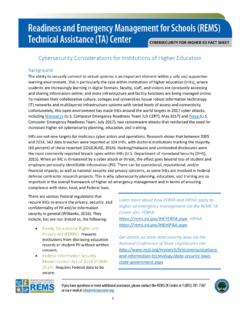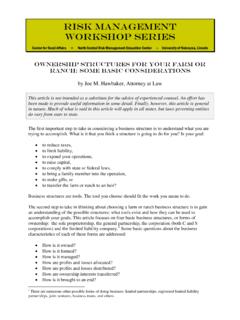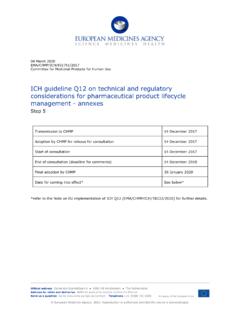Transcription of Operational considerations for COVID-19 management in …
1 -1- Operational considerations for COVID-19 management in the accommodation sector Interim guidance 31 March 2020 Background Several countries have demonstrated that COVID-19 transmission from one person to another can be slowed or stopped. This document has been prepared based on the evidence currently available about Coronavirus disease 2019 ( COVID-19 ) transmission (human-to -human transmission primarily via respiratory droplets from, or direct contact with, an infected person), and is designed to ensure that the accommodation sector can protect the health of its staff and clients. It should be used in conjunction with up-to -date information on the WHO COVID-19 website. The document is addressed to collective tourism accommodation establishments such as hotels and similar establishments, holiday and other short-stay accommodation , and campsites.
2 Private tourism accommodation providers are invited to follow the operating guidelines to the greatest extent In addition, the document will help any authority involved in public health to respond to a public health event in hotels and tourism accommodation establishments, including the International Health Regulations (IHR) National Focal Point (NFP), local health authorities, local, provincial, and national health surveillance and response system. The measures proposed here should be reviewed and adapted to the local context by the accommodation establishment s Workplace Health & Safety Committee, Prevention Officers and Services, and Health Consultants, or other relevant stakeholders who are responsible for health-related issues within an establishment, including administration and industry associations.
3 COVID-19 transmission According to current evidence, COVID-19 virus is transmitted between people through respiratory droplets (particularly when coughing). Direct contact with an infected person or indirect contact, (touching a surface or object that has been contaminated with respiratory secretions) and then touching their own mouth, nose, or eyes is another route of transmission. Although most infected people develop mild symptoms, severe disease may result in 1 Based on the United Nations International Recommendations for Tourism Statistics 2008 (available here) and the Glossary of Eurostat Statistics (available here). older people and/or people with other medical conditions and they may require rapid hospitalisation. Prevention measures include regular and thorough hand hygiene, social distancing, avoiding touching eyes, nose, and mouth, and good respiratory hygiene.
4 In public areas, cleaning and disinfecting frequently touched objects and surfaces can help reduce the risk of infection. Specifics of the tourism accommodation sector Hotels and tourism accommodation establishments are no more susceptible to contagion than other public establishments visited by large numbers of people who interact among themselves and with employees. Nevertheless, they are places where guests stay temporarily in close cohabitation and where there is a high degree of interaction among guests and workers. It is these aspects the lodging of guests in along with the services this entails (food and beverage, cleaning, activity organization, etc.) and the interactions specific to these establishments (guest-guest, guest-staff, and staff-staff) that require specific attention.
5 Every staff member must strictly comply with the basic protective measures against COVID-19 recommended by WHO, such as hand hygiene, physical distancing, avoid touching eyes, nose and mouth, practice respiratory hygiene and to heed the advice to stay home and seek medical attention if they have symptoms consistent with the disease. management team The management of the establishment should adopt a responsible attitude to address the health threat of COVID-19 . 1. Action plan The management Team, in consultation with local health authority, Hotel, Restaurant, Catering, and Tourism administration and industry associations should establish an action plan tailored to the situation and implement it in accordance with the recommendations of local and national public health authorities with the aim to prevent cases, effectively manage cases, and mitigate impact among clients and staff, including cleaning and Operational considerations for COVID-19 management in the accommodation sector : Interim guidance -2- disinfection of rooms occupied by ill persons.
6 The plan, which may incorporate teleworking, should be updated when necessary as a consequence of new guidance, procedures, or regulations issued by the pertinent authorities. 2. Mobilisation of resources The management Team should make sufficient human and economic resources available to ensure that the action plan can be implemented rapidly and effectively. The action plan should also include the provision of equipment and procedures, developed in collaboration with local health authorities, for the management of suspected case(s) and their possible contacts. 3. Supervision The implementation of the action plan and the effectiveness of the measures undertaken should be evaluated frequently to verify compliance, identify and correct gaps, and adapt the plan to practical experience. A Crisis Team involving members of each relevant department can support management in the implementation of the action plan and timely identification of required adjustments.
7 It is necessary to be alert to any unusual rise in worker absenteeism, especially those due to acute respiratory infections, possibly caused by COVID-19 . 4. Logbook of actions It is advisable to keep a logbook of the important actions and measures carried out and to record them in enough detail ( including date and time a disinfectant was used, by whom, where, etc.). This logbook can be used to improve the actions implemented. 5. Communication Communication should be maintained between management and staff, including through the managers in charge of the different departments, in order to pre-define an information policy for guests as well as to rapidly provide and obtain information on incidents that may arise in the establishment and to know the status of the situation at all times. Providing guidelines to the staff on how they should communicate the action plan to guests and other stakeholders can ensure alignment consistency.
8 Short documents or informative posters can amplify the key messages among guests and staff, including the promotion of hand-washing (at least 20 seconds, all parts of the hand), respiratory hygiene, and coughing etiquette. Official leaflets on basic hygiene practice and COVID-19 , in different languages, could be useful information tools. It may be useful to have an up-to -date list of the contact information of the staff, including emergency telephone numbers. 6. Training and information management should inform all staffs of the measures to be adopted and the measures that could protect their health and that of others, including the recommendation to stay home and seek medical attention if they have respiratory symptoms, such as coughing or shortness of breath. management should organize information briefings that should cover all the basic protective measures against COVID-19 and the signs and symptoms of the disease.
9 Training may be needed for specific procedures. Reception and concierge 1. Information and communication Reception desk staff should be sufficiently informed about COVID-19 so that they can safely carry out their assigned tasks and prevent the possible spread of COVID-19 within the establishment. They should be capable of informing guests who inquire about the establishment s policy in terms of the preventive measures established or other services that guests may require (for example, medical and pharmacy services available in the area or at the establishment itself). They should also be able to advise guests with respiratory symptoms to stay in their rooms until they are seen by a doctor management should arrange it immediately as well as to provide basic hygiene recommendations when asked. Reception desk staff, if possible, should not be older or with underlying health conditions.
10 Reception desk staff must take all necessary precautions, including physical distancing. Official, up-to -date information should be available about travel to and from countries or areas where COVID-19 is spreading. Reception Desk staff should be familiar with the room occupancy policy for accompanying persons in the event of a suspected case of COVID-19 . The latest definition of suspected case of COVID-19 can be found on WHO website. The reception desk should have immediately available the telephone numbers of the health authorities, medical centres, public and private hospitals, and assistance centres for use whenever there is the possibility that a guest may be ill. Operational considerations for COVID-19 management in the accommodation sector : Interim guidance -3- 2. Necessary equipment and medical kit at the reception desk Although the use of masks is not recommended for the public as a preventive measure, but only for those who are ill with COVID-19 symptoms or those caring for them, the reception desk should have a medical kit that includes the following items: Germicidal disinfectant/wipes for surface cleaning Tissues.















